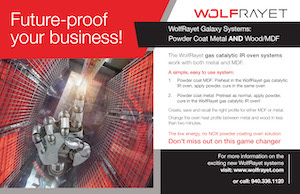Barbara Kanegsberg is President of BFK Solutions, an industry leader in critical cleaning consulting in the finishing industry.
She runs the company with her husband, Ed Kanegsberg. They founded the company in 1994 to evaluate products, facilities, and requirements for its customers.
How did you get your start in the finishing and coating industry?
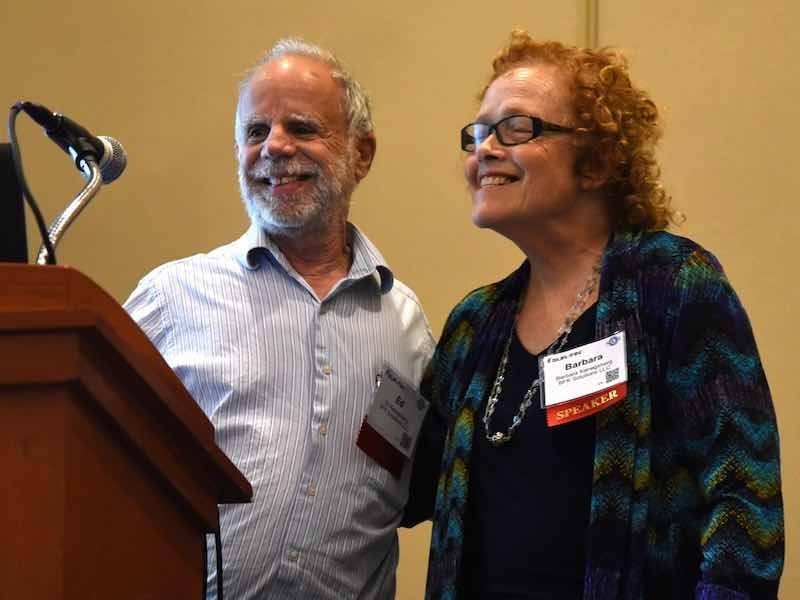 Ed and Barb Kanegsberg at SURFIN 2019In the mid-1980s, I began working as an aerospace analytical chemist. Compared with my previous work designing clinical laboratory tests, the activities were mind-numbing. My boss offered me the “opportunity” to head up the effort to replace ozone-depleting chemicals. He explained that none of the guys wanted to talk to each other or to change the cleaning methods. He said: Do it in your spare time; it won’t take much of your time “dear.” I never let him forget that he said “dear” and that he considered it to be a spare-time project. Engineers and managers from about six dozen divisions demanded solutions to cleaning and surface prep problems. The EPA wanted to know why I couldn’t immediately replace CFC-113 and 1,1,1-trichlorothane (two primary culprits of the day). Congress became involved – lots of political grumblings.
Ed and Barb Kanegsberg at SURFIN 2019In the mid-1980s, I began working as an aerospace analytical chemist. Compared with my previous work designing clinical laboratory tests, the activities were mind-numbing. My boss offered me the “opportunity” to head up the effort to replace ozone-depleting chemicals. He explained that none of the guys wanted to talk to each other or to change the cleaning methods. He said: Do it in your spare time; it won’t take much of your time “dear.” I never let him forget that he said “dear” and that he considered it to be a spare-time project. Engineers and managers from about six dozen divisions demanded solutions to cleaning and surface prep problems. The EPA wanted to know why I couldn’t immediately replace CFC-113 and 1,1,1-trichlorothane (two primary culprits of the day). Congress became involved – lots of political grumblings.
The military was vexed, stern, and vocal. I heard from cleaning chemistry and equipment suppliers, all claiming to have the magic “drop-in substitute” (no such thing). The corporation's president would storm down the hall, bellowing, “Where’s our Freon Lady.” This morphed into “The Cleaning Lady.” I oversaw an ODC (Ozone Depleting Chemical) replacement team. Because this was decades before web meetings, we traveled twice a year to meet face-to-face. We tested new cleaning processes, got the internal specs, and revised the mil-specs. I was gratified that the replacement processes were introduced without damaging people or products.
What does your job entail?
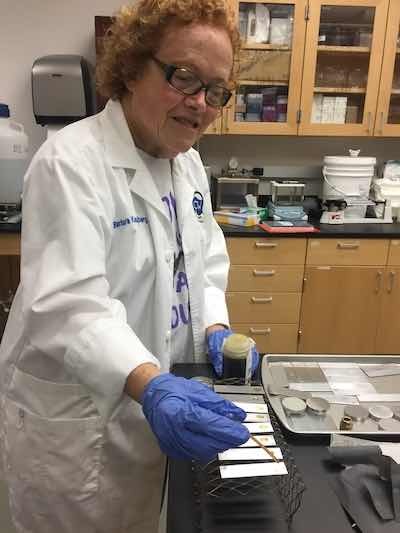 Barb Kanegsberg in Prof. Darren William’s lab at SHSU.I provide clients with ideas, information, and data to help them make great cleaning and surface prep decisions. Fancy reports don’t make the difference. The most important and most difficult aspect is to have frank, productive, two-way communication that fixes the problem and leads to reliable, hassle-free manufacturing. My job involves chemistry, engineering, biology, and economic analysis. I have to understand product performance requirements. Often, I have to untangle the cleaning and surface prep throughout the supply change. Any process solution has to work in the specific regulatory microclimate the client encounters.
Barb Kanegsberg in Prof. Darren William’s lab at SHSU.I provide clients with ideas, information, and data to help them make great cleaning and surface prep decisions. Fancy reports don’t make the difference. The most important and most difficult aspect is to have frank, productive, two-way communication that fixes the problem and leads to reliable, hassle-free manufacturing. My job involves chemistry, engineering, biology, and economic analysis. I have to understand product performance requirements. Often, I have to untangle the cleaning and surface prep throughout the supply change. Any process solution has to work in the specific regulatory microclimate the client encounters.
Can you walk us through a typical day for you?
Nope! Each day is a surprise. I start to do one thing; the next thing I know, there’s an urgent problem to solve. I interpret the results of analytical tests or spend time pouring over specifications. There are site visits, although, since COVID, many more are virtual. Virtual site visits work, especially with smartphones. The downside is not being able to shake hands with clients. The upside is that web meetings let you see faces up close on the screen; this is conducive to reading non-verbal concerns. Every day, I argue about projects with Ed Kanegsberg, my spouse and business partner. Our differences in perspective are ultimately helpful.
What do you like best about working in the finishing and coating industry?
I love the variety of applications, problems to be solved, and the number of options to solve a problem. I especially like talking to people with different educational backgrounds and diverse views about surface prep, surface quality, manufacturing, critical cleaning, politics, and religion. While diversity sometimes adds “heat of reaction” to the conversation, ultimately, we develop strategies. The diversity/differences of people involved in surface finishing make for a strong community.
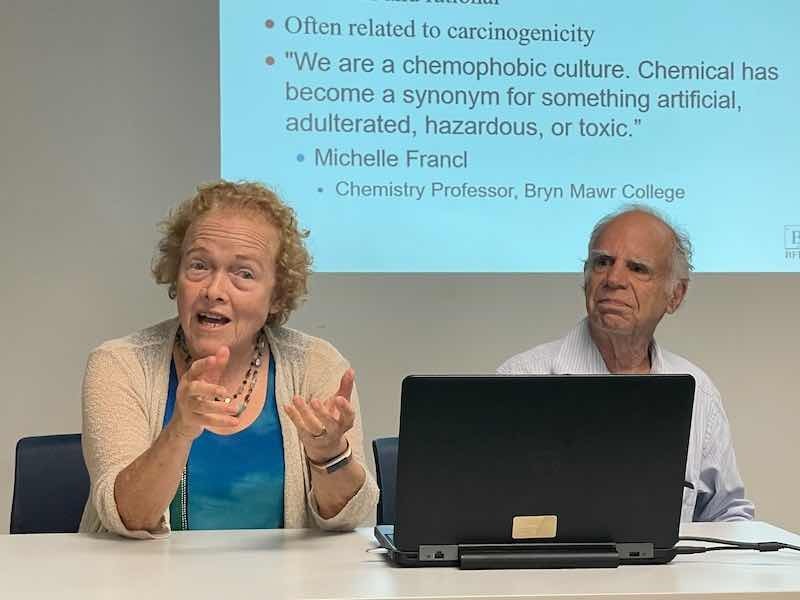 Ed and Barb at LA Sanitation District conference July 2023.What preconceived notions about the finishing and coating industry have changed since you started working in it?
Ed and Barb at LA Sanitation District conference July 2023.What preconceived notions about the finishing and coating industry have changed since you started working in it?
Growing up in New Jersey in the 1950s and 1960s, I had negative ideas about manufacturing, including finishing and coating. I thought working in manufacturing consisted of mind-numbing, soul-destroying jobs that involved punching a time clock, following arbitrary orders, and doing the same thing over and over and over until you either died or retired - basically punishment for not studying enough and/or becoming pregnant during high school. The world has changed; opportunities and manufacturing have changed; my views have changed. My first manufacturing work was in commercializing and automating clinical chemistry tests. Because biological systems are complex, I thought that problems in finishing and coating would be relatively easy to solve. Boy, was I wrong! The technology is evolving; cleaning challenges are increasing. After more than three decades in the field, I’m always amazed at how much more there is to learn.
Can you describe a project you have been involved in that made you most proud?
I am proud of projects where I learn, Ed and the client learn. I’m pleased when clients ask insightful, difficult questions. If I’m doing it right, I get fired at the end of a project (at least temporarily) because the manufacturers figure out how to solve surface prep problems that arise after the project ends. Sometimes, they contact me to say hi and maybe ask a quick question. Sometimes, projects come in stages over many years; perhaps the product line changes, throughput increases, or regulations become more restrictive. When clients see a thorny problem, when we work to address issues rationally – that’s fun.
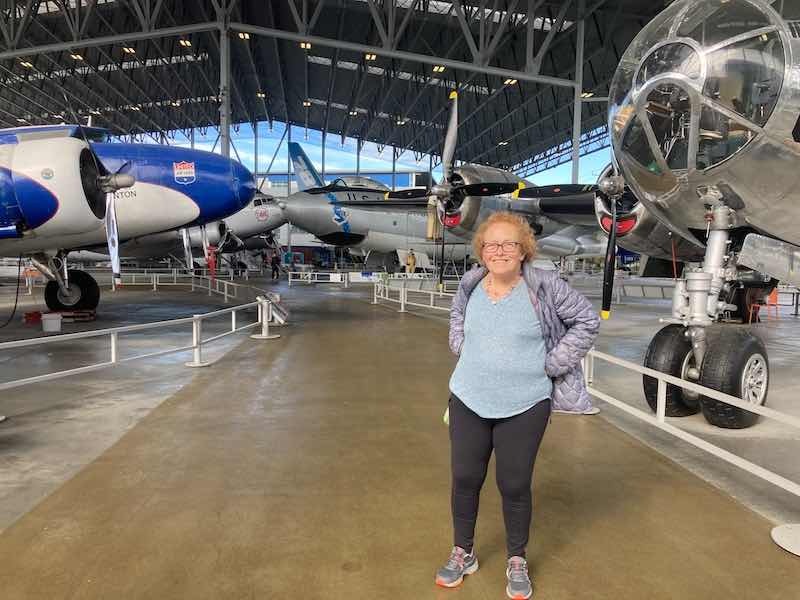 At Museum of Flight Seattle, October 2023.Why would you recommend a career in the finishing and coating industry to a friend?
At Museum of Flight Seattle, October 2023.Why would you recommend a career in the finishing and coating industry to a friend?
It depends on what my friend finds fun and challenging. There are opportunities in manufacturing, advanced coating technology, and analysis. Those who expect to set up a plant and change nothing for decades might want to consider another career path. Those who can accept and embrace change and those willing to enjoy finding new approaches to finishing and coating are likely to enjoy the field. There are problems combined with opportunities related to product design and customer requirements. Examples include a coating of 3D printed products, products involving post-printing processing, products containing mixes of metals and non-metals, miniaturization, and products where most of the product is surface. Even aggravation related to regulatory issues like Cr6+ and PFAS may provide an opportunity (I hope!).
What is the toughest part of your job?
Communication. The subtleties of language never cease to amaze me. My biggest challenge is communicating with Ed Kanegsberg.
How do you describe what you do in your job to family and friends and the importance of it?
I help people in the industry with the cleanliness of objects during manufacturing, use, and repair or restoration. The product has to be cleaned for successful finishing, painting, and functioning. You can’t paint a greasy wall. I evaluate problems for specific companies, and I also teach. Projects involve metal cleaning, optics, electronics, 3D printed parts, plastics, and mixed materials. Some fields include aerospace/aeronautics, implantable medical devices, consumer products, advanced automotive, high-value electronics, and fine arts. My clients include private manufacturers, the military, and the EPA. People call me “The Cleaning Lady,” but I don’t do windows. It’s easier to remember and spell than Kanegsberg. Besides, no one wants to be audited by a surface scientist; people will work with the Cleaning Lady.
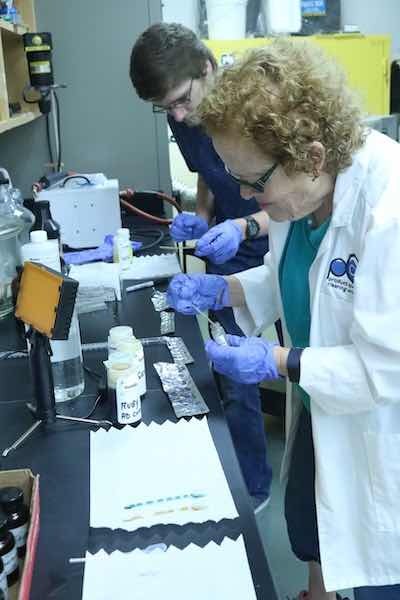 Are you involved in any industry associations or trade groups?
Are you involved in any industry associations or trade groups?
I work with several industry groups. I’m involved in the Product Quality Cleaning Workshops (PQCW), an informal collaboration involving BFK Solutions (Ed Kanegsberg and I), and Prof. Darren Williams, head of the Cleaning Research Group at Sam Houston State University. We have done a two-day in-person and two-week virtual workshops; we also do sponsored webinars and online courses. I’m helping ASTM develop cleaning standards and residue limits for medical devices. I am the Program Chair of the Surface Finishers Educational Association (SFEA). SFEA started in Southern California. Because we moved to a Zoom platform, the reach has become international.
What was the first job you had in your career?
In the 1960s, I was a lab assistant in synthetic organic chemistry - a field I knew nothing about. I quickly discovered that attempting to set a round-bottom flask directly on the lab bench leads to broken glass. I discovered that tossing sodium metal into a sink full of water resulted in a spectacular fire; the flames reached the ceiling.
What type of college, school, or training have you had?
My undergraduate degree is in biology from Bryn Mawr College. Bryn Mawr is a small women’s liberal arts college in Pennsylvania. I minored in chemistry, economics, and literature. Aside from the fact that Bryn Mawr looks a bit like Hogwarts, Bryn Mawr is attractive because the classes are small; my professors were teachers, not officious, disconnected academics who turn down their noses at the idea of actually interacting with students. More important than the specific courses – I learned how to learn. My Masters is in Biological Chemistry from Rutgers University. The most positive thing about Rutgers? I met Ed Kanegsberg.
Where do you see yourself in 5-10 years?
Many years ago, I set a goal of making the world better, safer, more productive, and more beautiful. I haven’t reached my goals yet, partly because the definition of those goals keeps evolving. Maybe next year.
What is your most humorous day/event in the finishing and coating industry?
If I didn’t have many humorous days, I might cry! A new client asked if I had had any experience in cleaning bearings. Sure! I replied, picturing small bearings I could easily hold in my hand. I went to a site with great confidence only to discover that the client was cleaning ginormous seismic protection bearings using a relatively small vapor degreaser with a manual hoist. Let’s just say that there was a splash zone. The immediate first step was to automate the process. Another was an exercise in multi-tasking. It was a sunny California weekend afternoon, and I was helping shop for a wedding dress for my then-future daughter-in-law. Her attendants were there to help with the evaluation process and to provide aesthetic input. No sooner had I entered the somewhat tony retail establishment when a client who manufactures funerary hardware needed quick answers to address an acute coating emergency. I found myself on my cell phone, hiding under piles of satin, lace, and jewel-encrusted gowns (who knew there were so many shades of white?) to separate the fashion and technical problems. I would alternatively duck down under the gowns to provide suggestions to the client about fixing the tales-from-the-crypt situation of poorly coated religious symbols and coffin corners (something I suspected the bride-to-be and other customers did not want to know about) and emerge to provide fashion advice and sending words of encouragement to the bride-to-be and her attendants. Somehow, both situations were resolved successfully.
What was your favorite subject in high school or college?
I was a total nerd at Trenton High School – definitely not one of the cool kids. My favorite subject was literature; it allowed me to escape from reality.
What motivates you to work hard at your job?
Solving problems. Solving a problem is like unraveling the plot of a murder mystery.
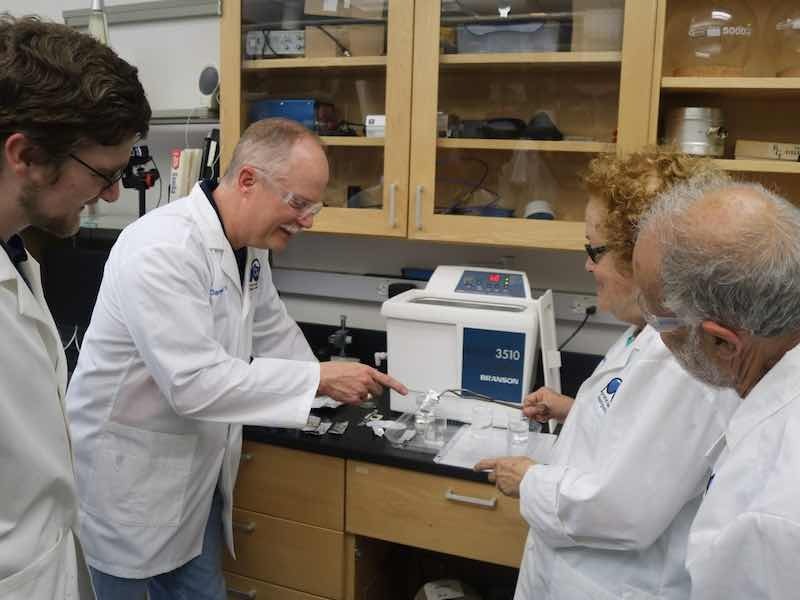 The Kanegsbergs in Prof. Darren William’s lab at SHSU.Tell us about your outside hobbies and interests:
The Kanegsbergs in Prof. Darren William’s lab at SHSU.Tell us about your outside hobbies and interests:
I love walking, gardening, traveling, reading, competitive shopping, yoga, staring mindlessly at the ocean. I love to design wire-wrap jewelry. Melding different colors and shapes of natural stone and crystal to create something beautiful is just joyful and makes me feel like a princess. Plus, wrapping the wire tightly around each bead is a socially acceptable outlet for what some might view as anti-social aggression. Weeding is good for that, too. Some days, I do more than a bit of gardening and wire-wrapping. Competitive shopping – at Costco or the Farmer’s Market gives me a feeling of accomplishment.
What three things do you think of the most each workday?
How can I solve the problem at hand? What other projects have I forgotten to work on? How can I teach the next generation to approach manufacturing rationally and thoughtfully?
Who has been the biggest mentor in your career?
I have been fortunate to have several mentors. Two go back to my early childhood. My dad, Israel Feinsilber, was a Wharton School graduate with a degree in statistics. He owned a very nice retail store that sold children’s clothing. He used to tell me, “The customer is always right, but you have to listen to what the customer says and what the customer means.” Even if he were exhausted, he would read me a bedtime story ending with “and the prince and princess got married and lived happily ever after; and Barbara, always find something you love to do. And never own your own business.” (OK, I followed the first two points.) My Uncle, Dr. Jacob J. Berman, was an old-time family doctor and an excellent scientist. When I was maybe eight years old, he would talk to me about topics in medicine, ethics, good experimental design, and - more importantly – how to watch out for bad science. He used the sadistic human experimentation by Nazi Dr. Mengele as an archetypal example of dreadful experimental design. It was rather intense for an 8-year-old, but I learned to assemble a well-designed experiment if I say so myself! Both drummed into me the need to be honest and to speak the truth.
What is your favorite book you have read?
I’m an avid (i.e., compulsive) reader – no all-time favorite. I love a well-crafted, well-written mystery. Malcolm Gladwell’s “Talking to Strangers” has been influential; it makes me question my assumptions about others.

























